Omni
ision ®
Advanced Information
Preliminary Datasheet
OV7670/OV7171 CMOS VGA (640x480) CAMERACHIPTM with OmniPixel ® Technology
General Description
The OV7670/OV7171 CAMERACHIPTM is a low voltage CMOS
image sensor that provides the full functionality of a
single-chip VGA camera and image processor in a small
footprint package. The OV7670/OV7171 provides full-frame,
sub-sampled or windowed 8-bit images in a wide range of
formats, controlled through the Serial Camera Control Bus
(SCCB) interface.
This product has an image array capable of operating at up
to 30 frames per second (fps) in VGA with complete user
control over image quality, formatting and output data
transfer. All required image processing functions, including
exposure control, gamma, white balance, color saturation,
hue control and more, are also programmable through the
SCCB interface. In addition, OmniVision CAMERACHIPs use
proprietary sensor technology to improve image quality by
reducing or eliminating common lighting/electrical sources of
image contamination, such as fixed pattern noise (FPN),
smearing, blooming, etc., to produce a clean, fully stable
color image.
Pb
Note: The OV7670/OV7171 uses a
lead-free package.
Features
•
•
•
•
•
•
•
•
•
•
•
•
•
•
•
•
High sensitivity for low-light operation
Low operating voltage for embedded portable apps
Standard SCCB interface compatible with I2C interface
Output support for Raw RGB, RGB (GRB 4:2:2,
RGB565/555/444), YUV (4:2:2) and YCbCr (4:2:2)
formats
Supports image sizes: VGA, CIF, and any size scaling
down from CIF to 40x30
VarioPixel® method for sub-sampling
Automatic image control functions including: Automatic
Exposure Control (AEC), Automatic Gain Control
(AGC), Automatic White Balance (AWB), Automatic
Band Filter (ABF), and Automatic Black-Level
Calibration (ABLC)
Image quality controls including color saturation, hue,
gamma, sharpness (edge enhancement), and
anti-blooming
ISP includes noise reduction and defect correction
Supports LED and flash strobe mode
Supports scaling
Lens shading correction
Flicker (50/60 Hz) auto detection
Saturation level auto adjust (UV adjust)
Edge enhancement level auto adjust
De-noise level auto adjust
Ordering Information
Product
OV07670-VL2A (Color, lead-free)
OV07171-VL2A (B&W, lead-free)
Package
24 pin CSP2
24 pin CSP2
Applications
•
•
•
•
Cellular and Picture Phones
Toys
PC Multimedia
Digital Still Cameras
Key Specifications
Active Array Size 640 x 480
Power Supply
Power
Requirements
Temperature
Range
Digital Core 1.8VDC +10%
Analog 2.45V to 3.0V
I/O 1.7V to 3.0Va
Active 60 mW typical
Standby < 20 µA
Operation -30°C to 70°C
Stable Image 0°C to 50°C
(15fps VGA YUV format)
Output Formats (8-bit)
• YUV/YCbCr 4:2:2
• RGB565/555/444
• GRB 4:2:2
• Raw RGB Data
Lens Size 1/6"
Chief Ray Angle 25°
Maximum Image
Transfer Rate 30 fps for VGA
Sensitivity 1.3 V/(Lux • sec)
S/N Ratio 46 dB
Dynamic Range 52 dB
Scan Mode Progressive
Electronics Exposure Up to 510:1 (for selected fps)
Pixel Size 3.6 µm x 3.6 µm
Dark Current 12 mV/s at 60°C
Well Capacity 17 K e
Image Area 2.36 mm x 1.76 mm
Package Dimensions 3785 µm x 4235 µm
a.
I/O power should be 2.45V or higher when using the internal
regulator for Core (1.8V); otherwise, it is necessary to provide
an external 1.8V for the Core power supply.
Figure 1 OV7670/OV7171 Pin Diagram (Top View)
A1
A2
A3
AVDD
SIO_D
SIO_C
B1
B2
B3
PWDN
VREF2
AGND
A4
D1
B4
D0
A5
D3
B5
D2
C1
C2
DVDD
VREF1
D1
D2
VSYNC
HREF
OV7670/OV7171
E1
E2
E3
PCLK
STROBE
XCLK
F1
F2
F3
DOVDD
RESET#
DOGND
E4
D7
F4
D6
E5
D5
F5
D4
Version 1.3, April 5, 2006
Proprietary to OmniVision Technologies
1
�
OV7670/OV7171
CMOS VGA (OmniPixel®) CAMERACHIP™
Omni
ision
Functional Description
Figure 2 shows the functional block diagram of the OV7670/OV7171 image sensor. The OV7670/OV7171 includes:
•
•
•
•
•
•
•
•
•
•
Image Sensor Array (total array of 656 x 488 pixels, with active pixels 640 x 480 in YUV mode)
Analog Signal Processor
A/D Converters
Test Pattern Generator
Digital Signal Processor (DSP)
Image Scaler
Timing Generator
Digital Video Port
SCCB Interface
LED and Strobe Flash Control Output
Figure 2 Functional Block Diagram
Buffer
Buffer
Analog
Processing
G
R
B
Test
Pattern
Generator
A/D
DSP
(Lens shading
correction,
de-noise, white/
black pixel
correction, auto
white balance,
etc.)
50/60 Hz
Auto
Detect
Image
Scaler
FIFO
Video
Port
D[7:0]
Column Sense Amp
Exposure/Gain
Detect
t
c
e
l
e
S
w
o
R
Image Array
(656 x 488)
Clock
Video Timing Generator
Exposure/Gain
Control
Registers
SCCB
Interface
XCLK
STROBE
HREF
PCLK
VSYNC
RESET#
PWDN
SIO_C
SIO_D
2
Proprietary to OmniVision Technologies
Version 1.3, April 5, 2006
�
Omni
ision
Functional Description
Image Sensor Array
Test Pattern Generator
The OV7670/OV7171 sensor has an image array of
656 x 488 pixels for a total of 320,128 pixels, of which
640 x 480 pixels are active (307,200 pixels). Figure 3
shows a cross-section of the image sensor array.
The Test Pattern Generator features the following:
•
•
•
8-bar color bar pattern
Fade-to-gray color bar pattern
Shift "1" in output pin
Figure 3 Image Sensor Array
Microlens
Digital Signal Processor (DSP)
Glass
Blue
Green
Red
Timing Generator
In general, the timing generator controls the following
functions:
•
•
•
•
•
Array control and frame generation
Internal timing signal generation and distribution
Frame rate timing
Automatic Exposure Control (AEC)
External timing outputs (VSYNC, HREF/HSYNC, and
PCLK)
Analog Signal Processor
This block performs all analog image functions including:
•
•
Automatic Gain Control (AGC)
Automatic White Balance (AWB)
A/D Converters
After the Analog Processing block, the bayer pattern Raw
signal is fed to a 10-bit analog-to-digital (A/D) converter
shared by G and BR channels. This A/D converter
operates at speeds up to 12 MHz and is fully synchronous
to the pixel rate (actual conversion rate is related to the
frame rate).
In addition to the A/D conversion, this block also has the
following functions:
•
• Optional U/V channel delay
•
Digital Black-Level Calibration (BLC)
Additional A/D range controls
In general, the combination of the A/D Range Multiplier
and A/D Range Control sets the A/D range and maximum
value to allow the user to adjust the final image brightness
as a function of the individual application.
•
This block controls the interpolation from Raw data to
RGB and some image quality control.
•
Edge enhancement (a two-dimensional high pass
filter)
Color space converter (can change Raw data to RGB
or YUV/YCbCr)
RGB matrix to eliminate color cross talk
•
Hue and saturation control
•
• White/black pixel correction
•
•
•
•
De-noise
Lens shading correction
Programmable gamma control
Transfer 10-bit data to 8-bit
Image Scaler
This block controls all output and data formatting required
prior to sending the image out. This block scales
YUV/RGB output from VGA to CIF and almost any size
under CIF.
Digital Video Port
Register bits COM2[1:0] increase IOL/IOH drive current
and can be adjusted as a function of the customer’s
loading.
SCCB Interface
The Serial Camera Control Bus (SCCB) interface controls
to OmniVision
the CAMERACHIP operation. Refer
Technologies Serial Camera Control Bus
(SCCB)
Specification for detailed usage of the serial control port.
LED and Strobe Flash Control Output
The OV7670/OV7171 has a Strobe mode that allows it to
work with an external flash and LED.
Version 1.3, April 5, 2006
Proprietary to OmniVision Technologies
3
�
Omni
ision
Pin Description
Pin Description
Table 1
Pin Description
Pin Number
Name
Pin Type
Function/Description
A1
A2
A3
A4
A5
B1
B2
B3
B4
B5
C1
C2
D1
D2
E1
E2
E3
E4
E5
F1
F2
F3
F4
F5
AVDD
SIO_D
SIO_C
D1a
D3
Power
Analog power supply
I/O
Input
Output
Output
SCCB serial interface data I/O
SCCB serial interface clock input
YUV/RGB video component output bit[1]
YUV/RGB video component output bit[3]
PWDN
Input (0)b
Power Down Mode Selection
0: Normal mode
1: Power down mode
VREF2
AGND
D0
D2
DVDD
VREF1
VSYNC
HREF
PCLK
STROBE
XCLK
D7
D5
DOVDD
Reference
Reference voltage - connect to ground using a 0.1 µF capacitor
Power
Output
Output
Power
Analog ground
YUV/RGB video component output bit[0]
YUV/RGB video component output bit[2]
Power supply (+1.8 VDC) for digital logic core
Reference
Reference voltage - connect to ground using a 0.1 µF capacitor
Output
Output
Output
Output
Input
Output
Output
Power
Vertical sync output
HREF output
Pixel clock output
LED/strobe control output
System clock input
YUV/RGB video component output bit[7]
YUV/RGB video component output bit[5]
Digital power supply for I/O (1.7V ~ 3.0V)
Clears all registers and resets them to their default values.
RESET#
Input
DOGND
D6
D4
Power
Output
Output
0: Reset mode
1: Normal mode
Digital ground
YUV/RGB video component output bit[6]
YUV/RGB video component output bit[4]
a.
b.
D[7:0] for 8-bit YUV or RGB (D[7] MSB, D[0] LSB)
Input (0) represents an internal pull-down resistor.
Version 1.3, April 5, 2006
Proprietary to OmniVision Technologies
4
�
OV7670/OV7171
CMOS VGA (OmniPixel®) CAMERACHIP™
Omni
ision
Electrical Characteristics
Table 2
Ambient Storage Temperature
Absolute Maximum Ratings
Supply Voltages (with respect to Ground)
-40ºC to +95ºC
VDD-A
VDD-C
VDD-IO
4.5 V
3 V
4.5 V
All Input/Output Voltages (with respect to Ground)
Lead-free Temperature, Surface-mount process
-0.3V to VDD-IO+0.5V
245ºC
NOTE: Exceeding the Absolute Maximum ratings shown above invalidates all AC and DC electrical specifications and may
result in permanent device damage.
Table 3
DC Characteristics (-30°C < TA < 70°C)
Symbol
Parameter
Condition
DC supply voltage – Analog
DC supply voltage – Digital Core
DC supply voltage – I/O power
Active (Operating) Current
Standby Current
VDD-A
VDD-C
VDD-IO
IDDA
IDDS-SCCB
IDDS-PWDN Standby Current
VIH
VIL
VOH
VOL
IOH
IOL
IL
a.
Input voltage HIGH
Input voltage LOW
Output voltage HIGH
Output voltage LOW
Output current HIGH
Output current LOW
Input/Output Leakage
VDD-A = 2.5V, VDD-C = 1.8V, VDD-IO = 2.5V
IDDA = ∑{IDD-IO+ IDD-C + IDD-A}, fCLK = 24MHz at 30 fps YUV output, no I/O loading
IDD-C = 10mA, IDD-A = 8mA, without loading
VDD-A = 2.5V, VDD-C = 1.8V, VDD-IO = 2.5V
IDDS-SCCB refers to a SCCB-initiated Standby, while IDDS-PWDN refers to a PWDN pin-initiated Standby
Standard Output Loading = 25pF, 1.2KΩ
b.
c.
d.
–
–
–
See Note a
See Note c
Min
2.45
1.62
1.7
Typ
2.75
1.8
–
10 + 8b
1
10
Max
3.0
1.98
3.0V
20
CMOS
0.7 x VDD-IO
CMOS
0.9 x VDD-IO
See Note d
GND to VDD-IO
8
15
0.3 x VDD-IO
0.1 x VDD-IO
± 1
Unit
V
V
V
mA
mA
µA
V
V
V
V
mA
mA
µA
5
Proprietary to OmniVision Technologies
Version 1.3, April 5, 2006
�
Omni
ision
Electrical Characteristics
Table 4
Functional and AC Characteristics (-30°C < TA < 70°C)
Symbol
Parameter
Min
Typ
Max
Functional Characteristics
A/D
A/D
AGC
Differential Non-Linearity
Integral Non-Linearity
Range
Red/Blue Adjustment Range
+ 1/2
+ 1
30
12
Unit
LSB
LSB
dB
dB
MHz
ns
%
ms
ms
KHz
μs
ns
ns
μs
ns
ns
μs
ns
ns
ns
ns
ns
ns
ns
ns
ns
10
21
45
24
42
50
0
100
600
Clock Frequency
400
900
Clock Duty Cycle
48
100
55
1
300
Clock Low Period
Clock High Period
Input Clock Period
Input Clock Frequency
SIO_C low to Data Out valid
Bus free time before new START
Setting time after software/hardware reset
Settling time for register change (10 frames required)
Inputs (PWDN, CLK, RESET#)
fCLK
tCLK
tCLK:DC
tS:RESET
tS:REG
SCCB Timing (see Figure 4)
fSIO_C
tLOW
tHIGH
tAA
tBUF
tHD:STA
tSU:STA
tHD:DAT
tSU:DAT
tSU:STO
tR, tF
tDH
Outputs (VSYNC, HREF, PCLK, and D[7:0] (see Figure 5, Figure 6, Figure 7, Figure 9, and Figure 10)
tPDV
tSU
tHD
tPHH
tPHL
START condition Setup time
STOP condition Setup time
START condition Hold time
PCLK[↓] to Data-out Valid
SCCB Rise/Fall times
PCLK[↓] to HREF[↓]
PCLK[↓] to HREF[↑]
Data-out Hold time
Data-in Setup time
1.3
600
100
1.3
600
600
D[7:0] Setup time
Data-in Hold time
50
15
8
0
0
300
5
5
5
D[7:0] Hold time
AC
Conditions:
• VDD: VDD-C = 1.8V, VDD-A = 2.5V, VDD-IO = 2.5V
• Rise/Fall Times: I/O: 5ns, Maximum
SCCB: 300ns, Maximum
• Input Capacitance: 10pf
• Output Loading: 25pF, 1.2KΩ to 2.5V
• fCLK: 24MHz
Version 1.3, April 5, 2006
Proprietary to OmniVision Technologies
6
�
OV7670/OV7171
CMOS VGA (OmniPixel®) CAMERACHIP™
Omni
ision
Timing Specifications
Figure 4 SCCB Timing Diagram
tF
tHIGH
tR
tLOW
tSU:STA
tHD:STA
tHD:DAT
tSU:DAT
tSU:STO
tAA
tDH
tBUF
SIO_C
SIO_D
IN
SIO_D
OUT
Figure 5 Horizontal Timing
PCLK
HREF
tPHL
tPCLK
tSU
tHD
(Row Data)
tPHL
D[7:0]
Last Byte
First Byte
Last Byte
Figure 6 VGA Frame Timing
3 x tLINE
17 tLINE
VSYNC
HREF
HSYNC
tPDV
510 x tLINE
480 x tLINE
tLINE = 784 tP
144 tP
10 tLINE
640 tP
80 tP
45 tP
19 tP
D[7:0]
Invalid Data
Invalid Data
P0 - P639
Row 0
Row 1
Row 2
Row 479
NOTE:
For Raw data, tP = tPCLK
For YUV/RGB, tP = 2 x tPCLK
7
Proprietary to OmniVision Technologies
Version 1.3, April 5, 2006
�
Timing Specifications
Omni
ision
Figure 7 QVGA Frame Timing
VGA HREF
(see Figure 7,
VGA Frame Timing)
QVGA HREF
Figure 8 QQVGA Frame Timing
VGA HREF
(see Figure 7,
VGA Frame Timing)
QQVGA HREF
(1 from 4,
120 from 480)
Figure 9 CIF Frame Timing
VGA HREF
(see Figure 7,
VGA Frame Timing)
CIF HREF
(3 from 5)
Figure 10 QCIF Frame Timing
QVGA HREF
(see Figure 7,
QVGA Frame Timing)
QCIF HREF
(3 from 5)
Version 1.3, April 5, 2006
Proprietary to OmniVision Technologies
8
�
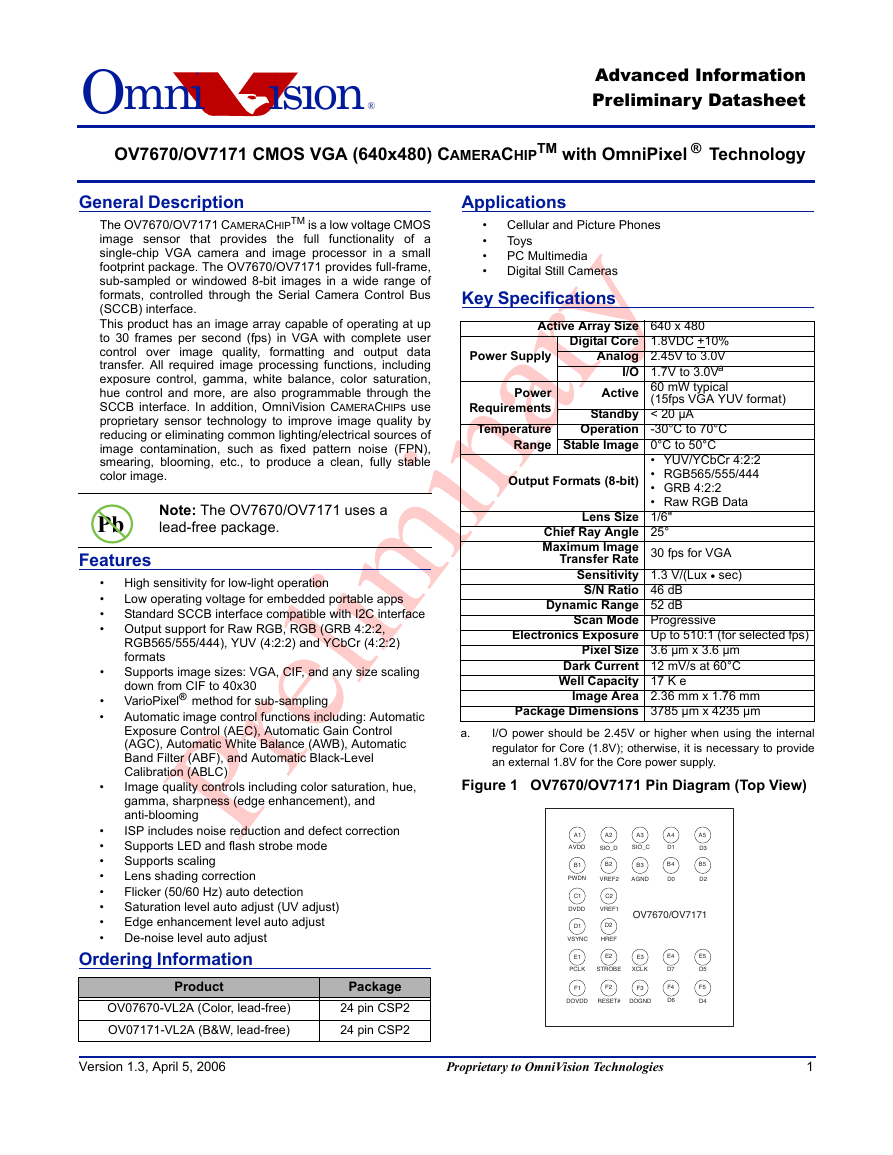
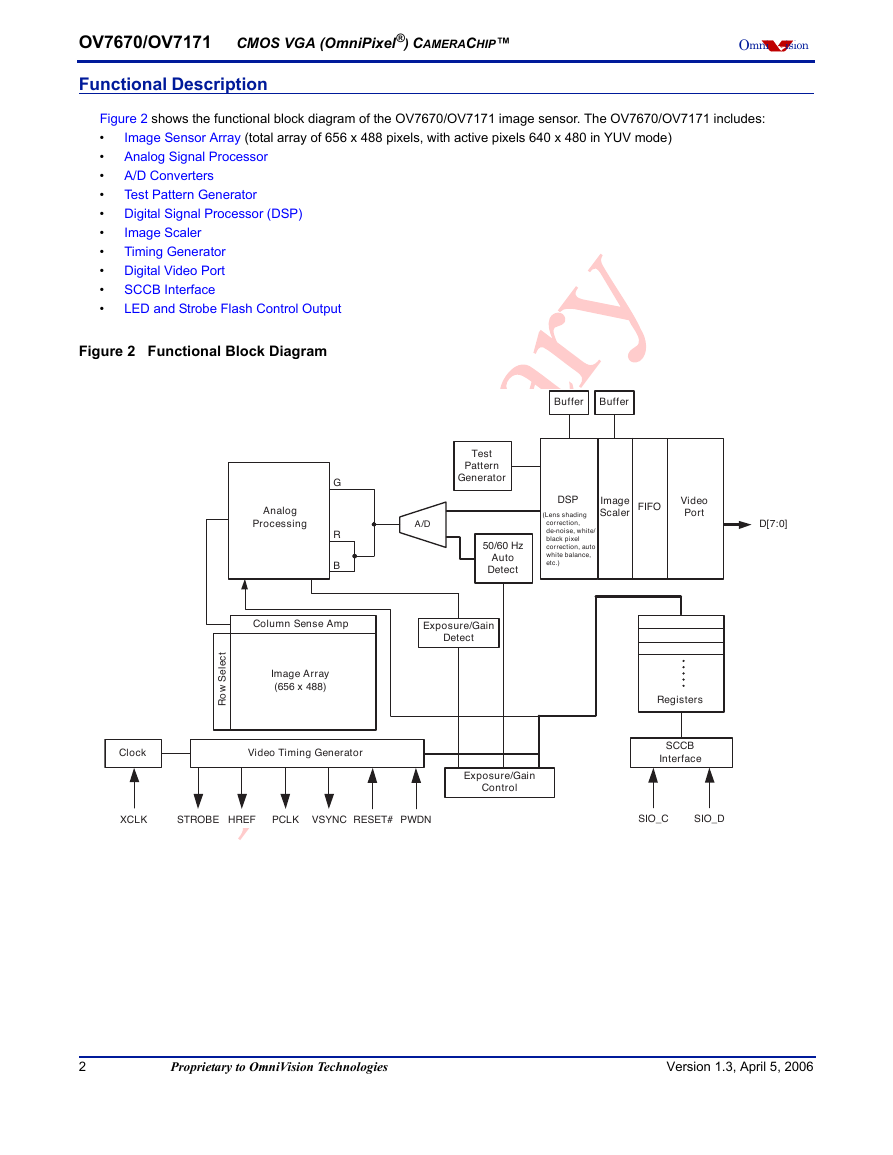

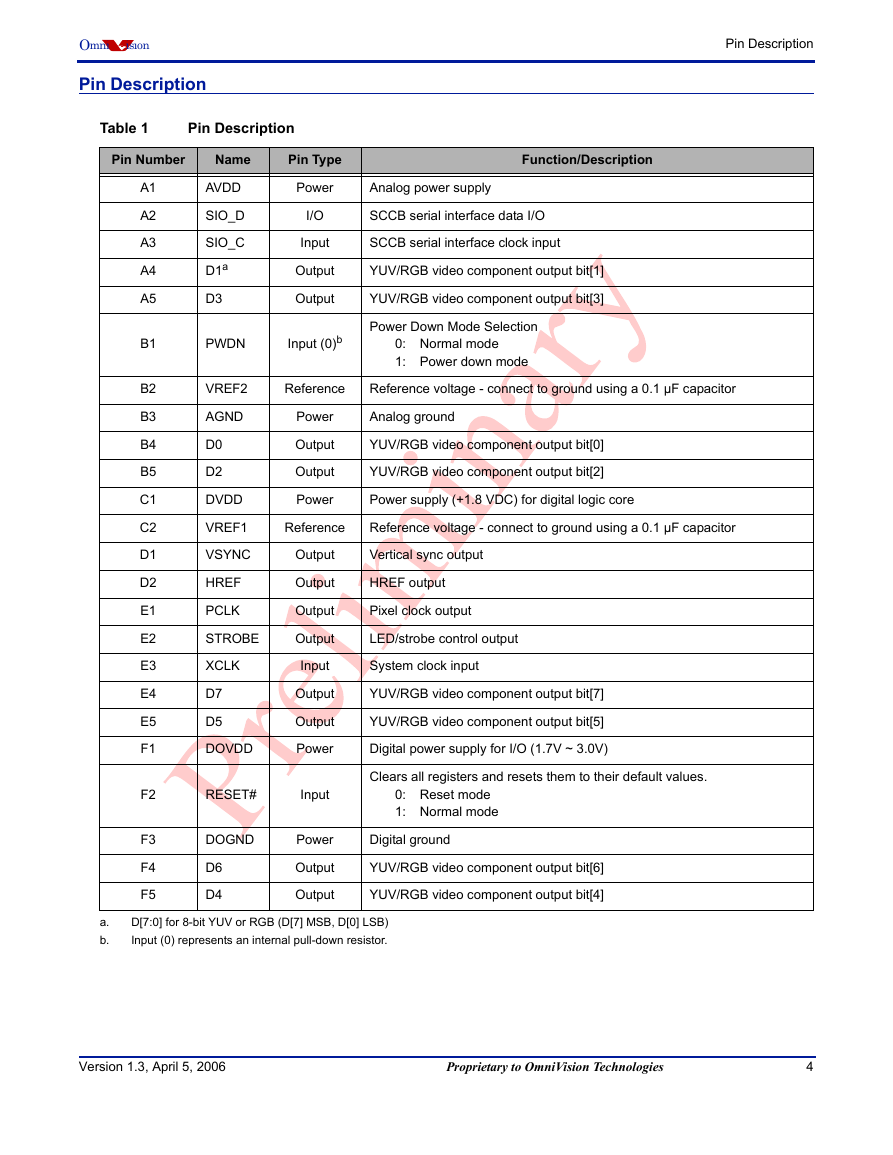
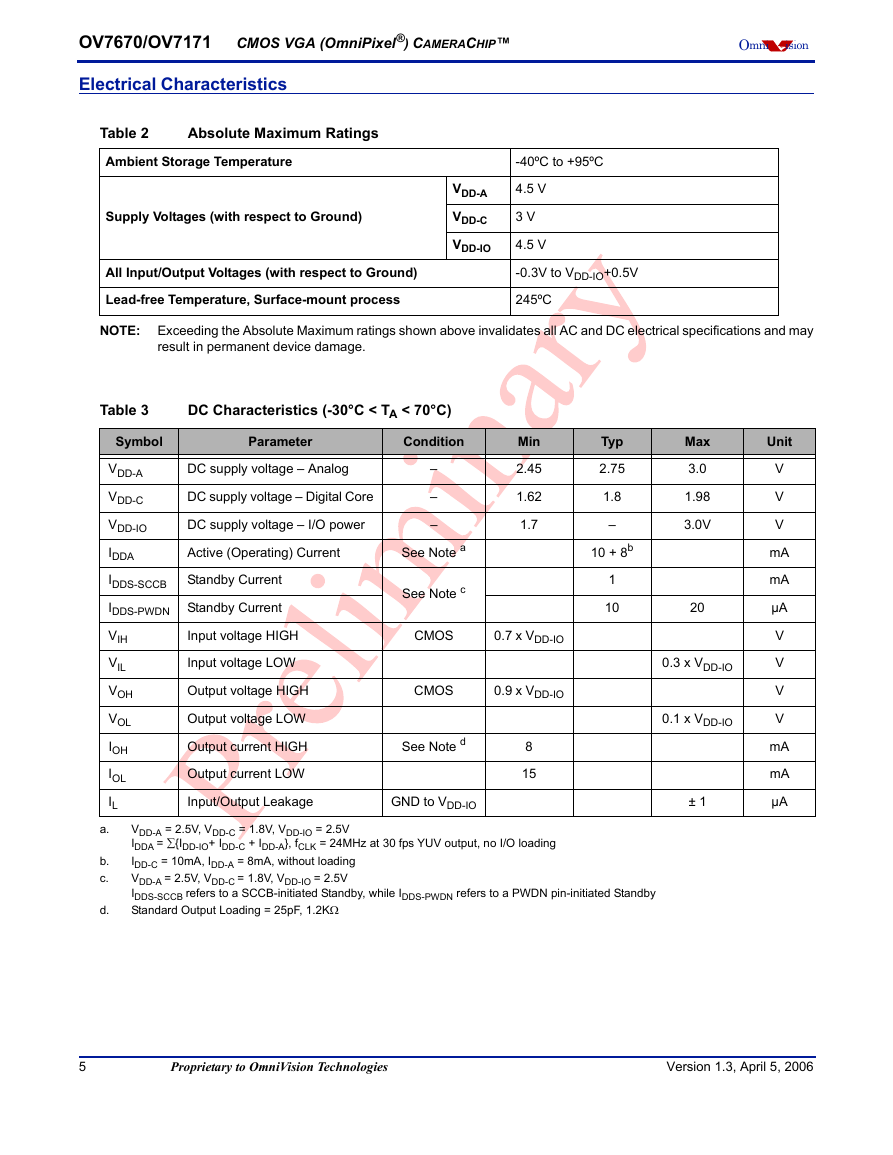

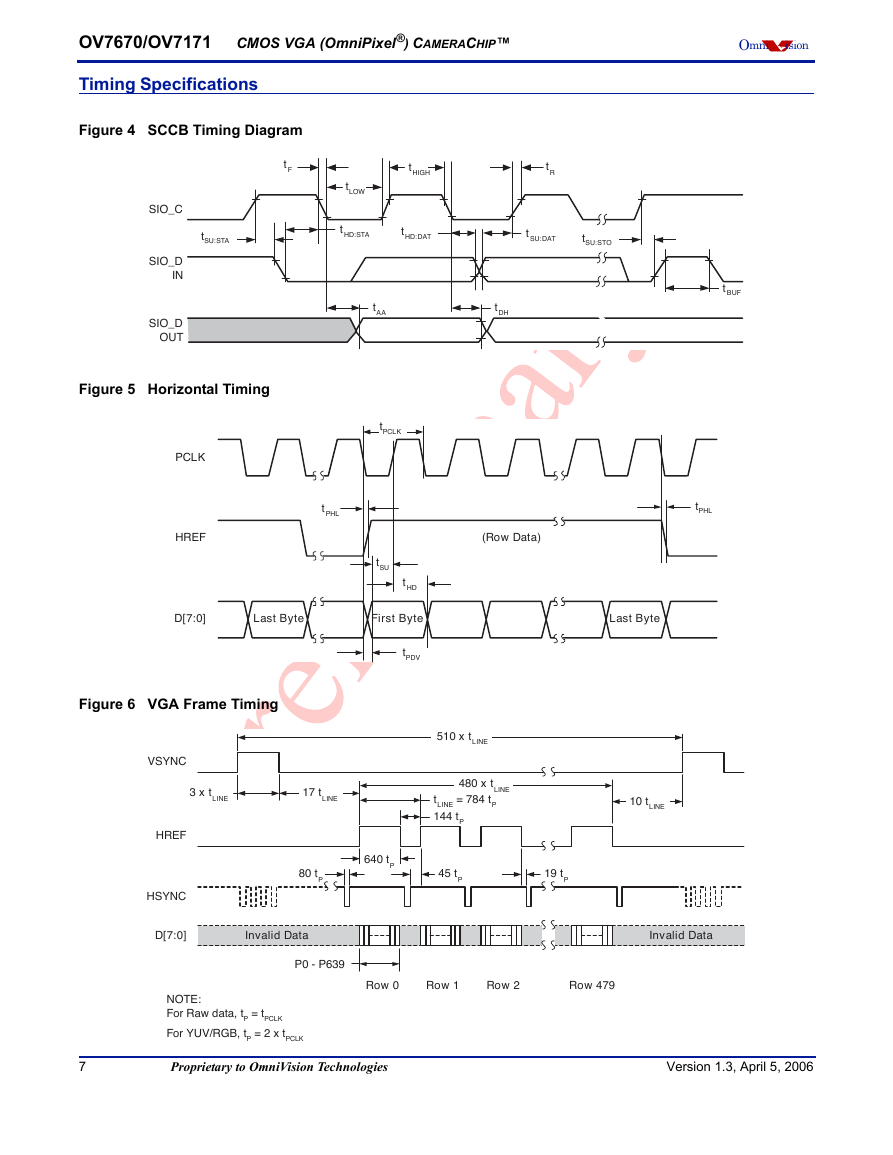









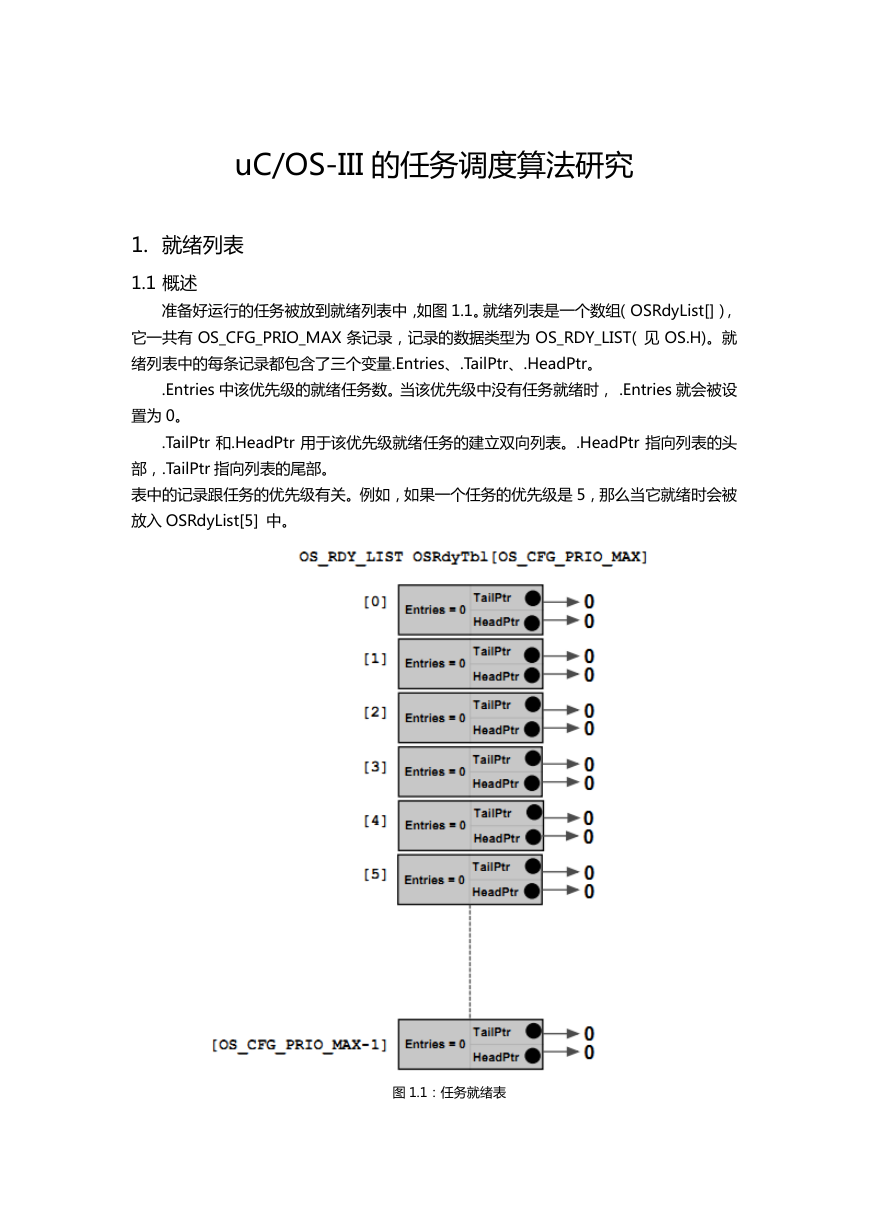 uCOS-III的任务调度算法研究.pdf
uCOS-III的任务调度算法研究.pdf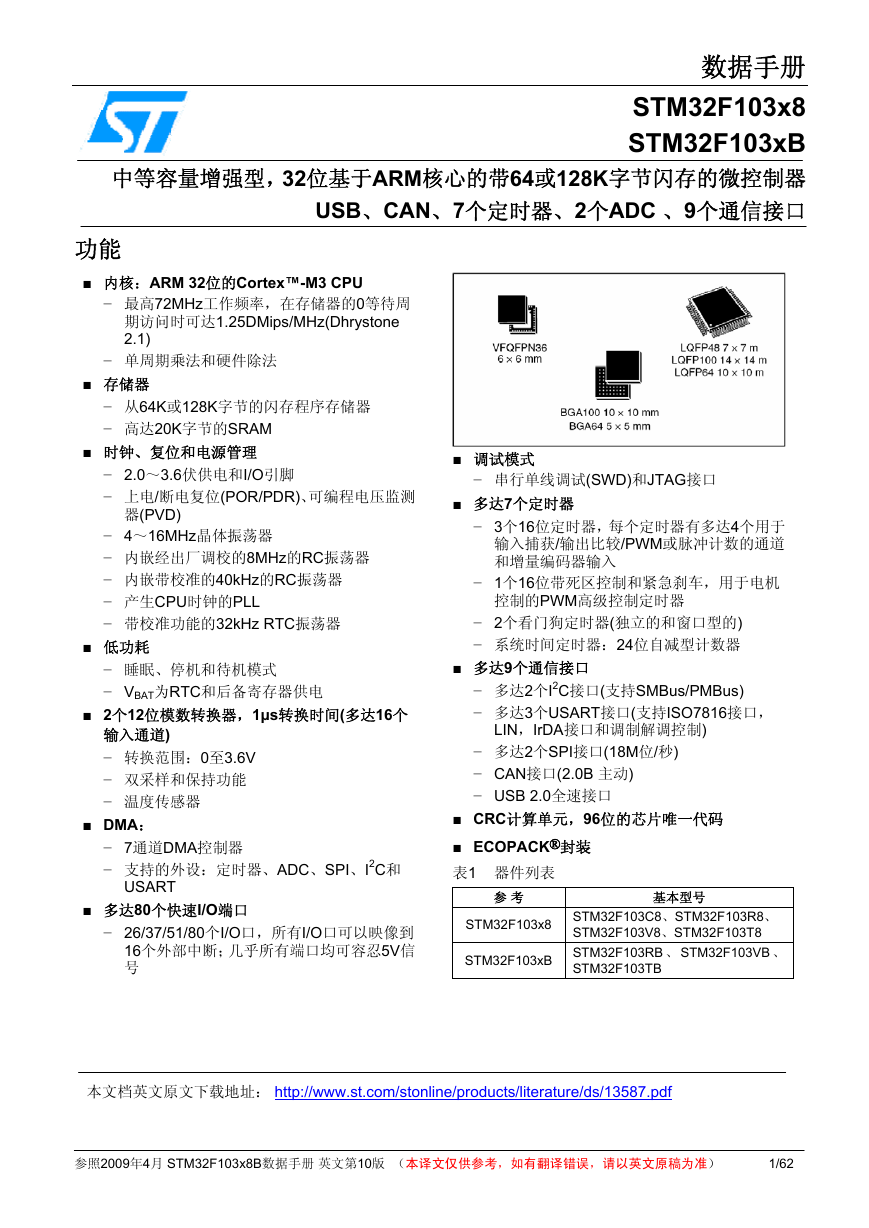 STM32F103x8B_DS_CH_V10(7STM32中文数据手册).pdf
STM32F103x8B_DS_CH_V10(7STM32中文数据手册).pdf FX2N系列PLC培训教程.pdf
FX2N系列PLC培训教程.pdf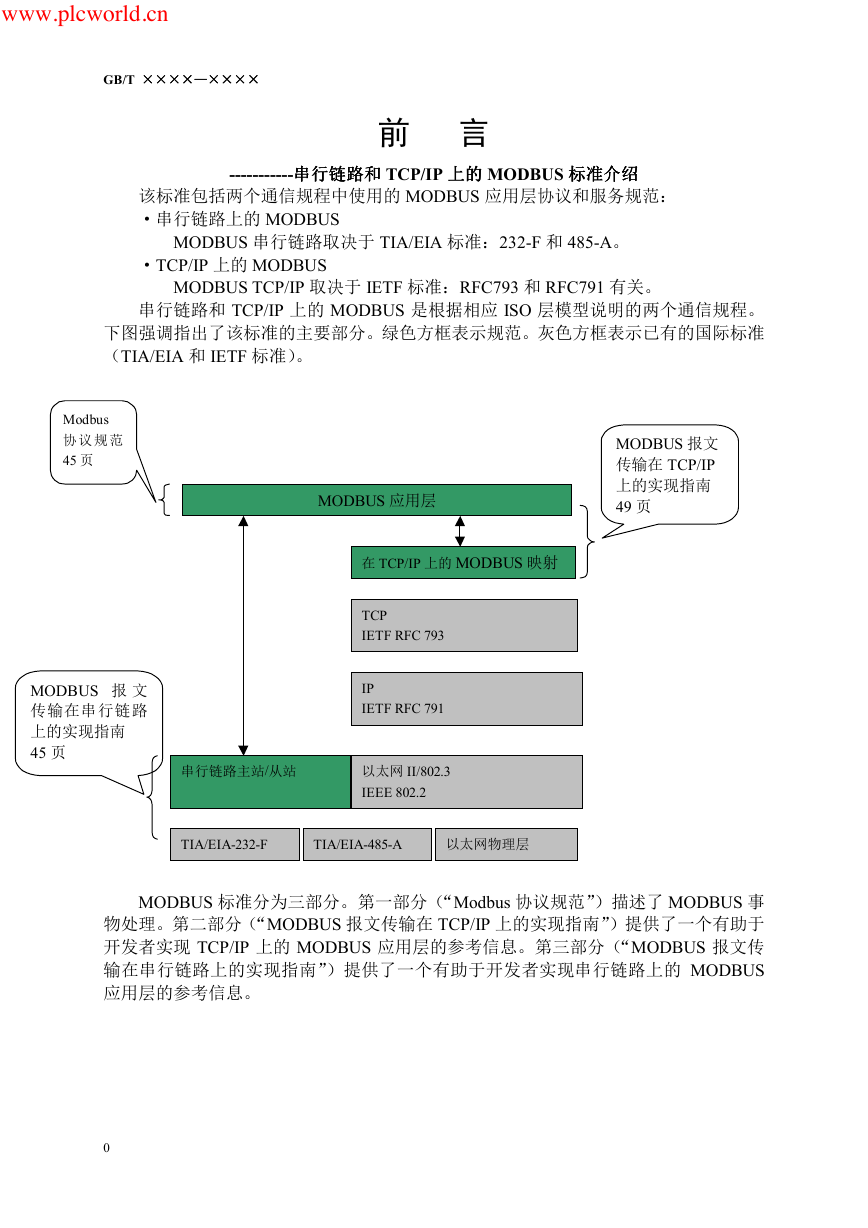 Modbus协议资料.pdf
Modbus协议资料.pdf WM8978中文资料(芯片资料).doc
WM8978中文资料(芯片资料).doc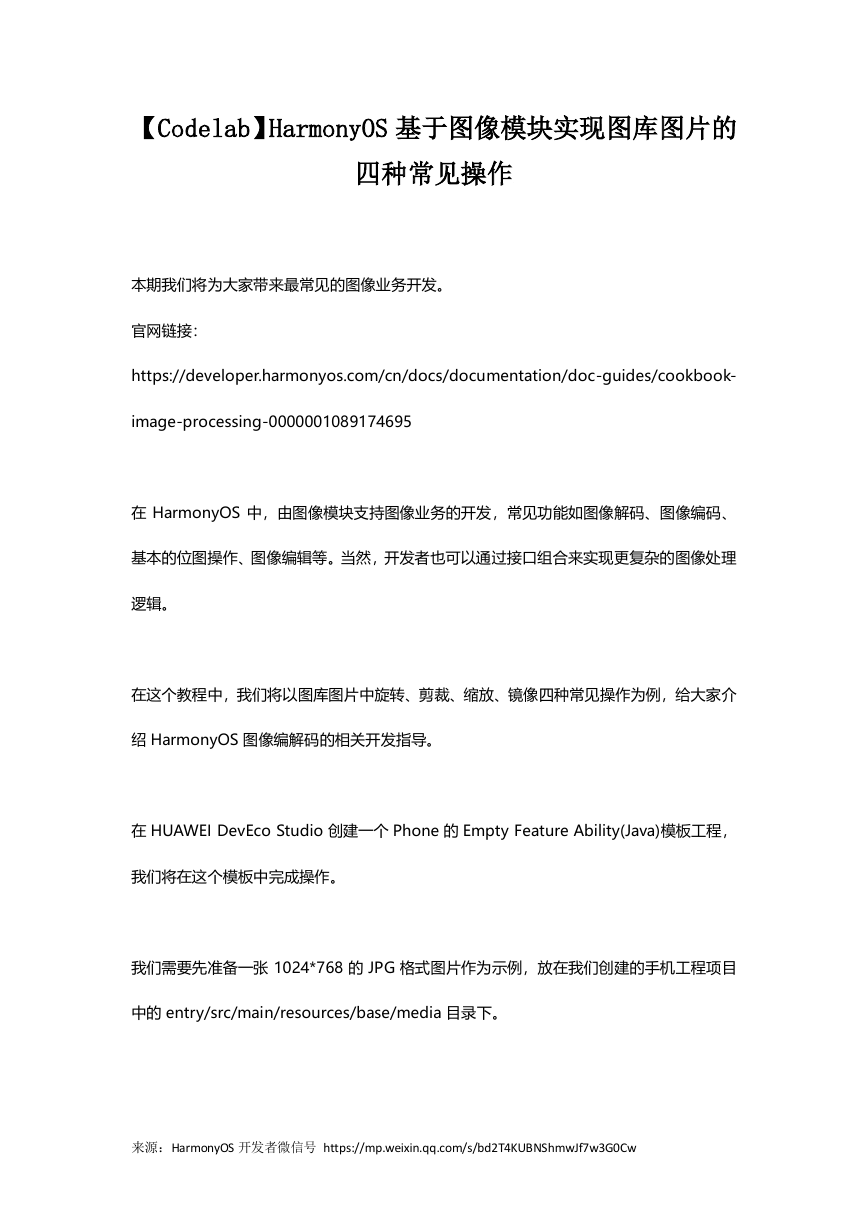 5-1.【Codelab】HarmonyOS基于图像模块实现图库图片的四种常见操作.pdf
5-1.【Codelab】HarmonyOS基于图像模块实现图库图片的四种常见操作.pdf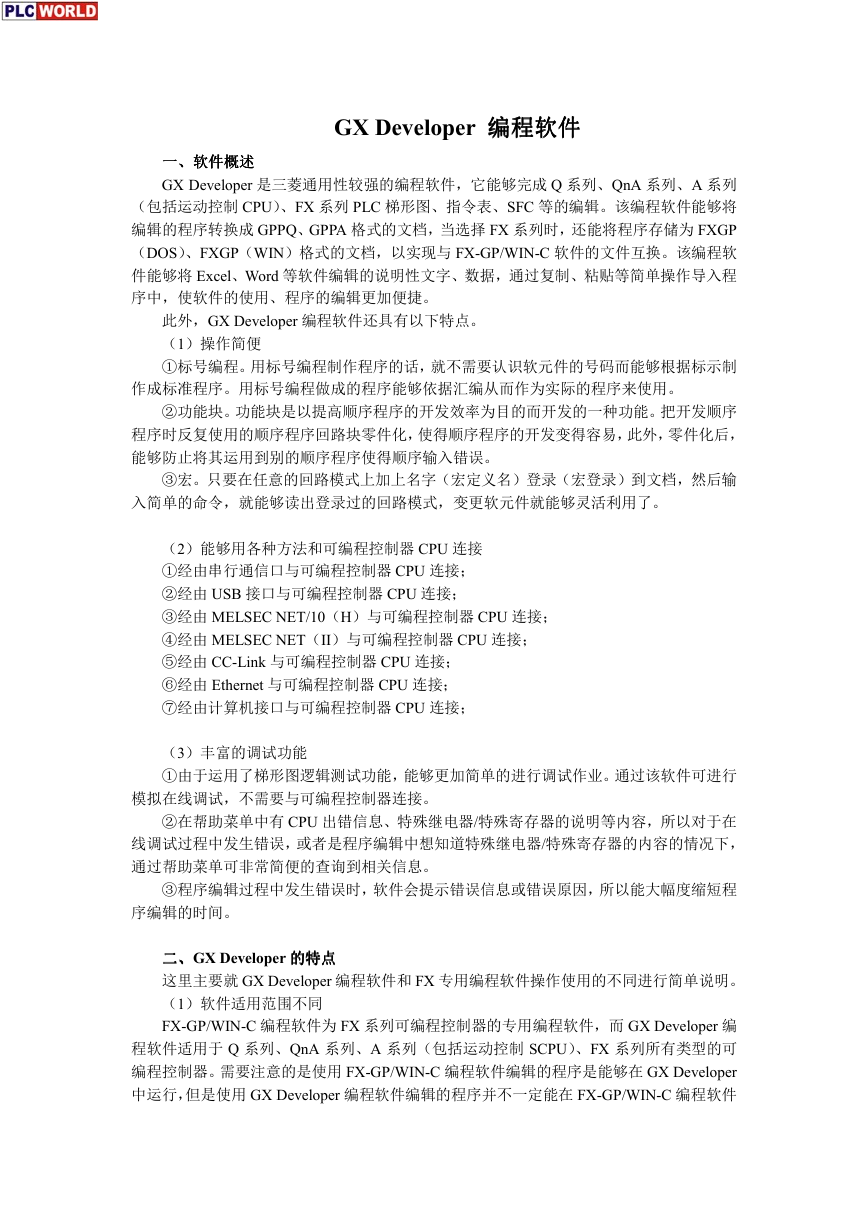 GX Developer 编程软件使用说明.pdf
GX Developer 编程软件使用说明.pdf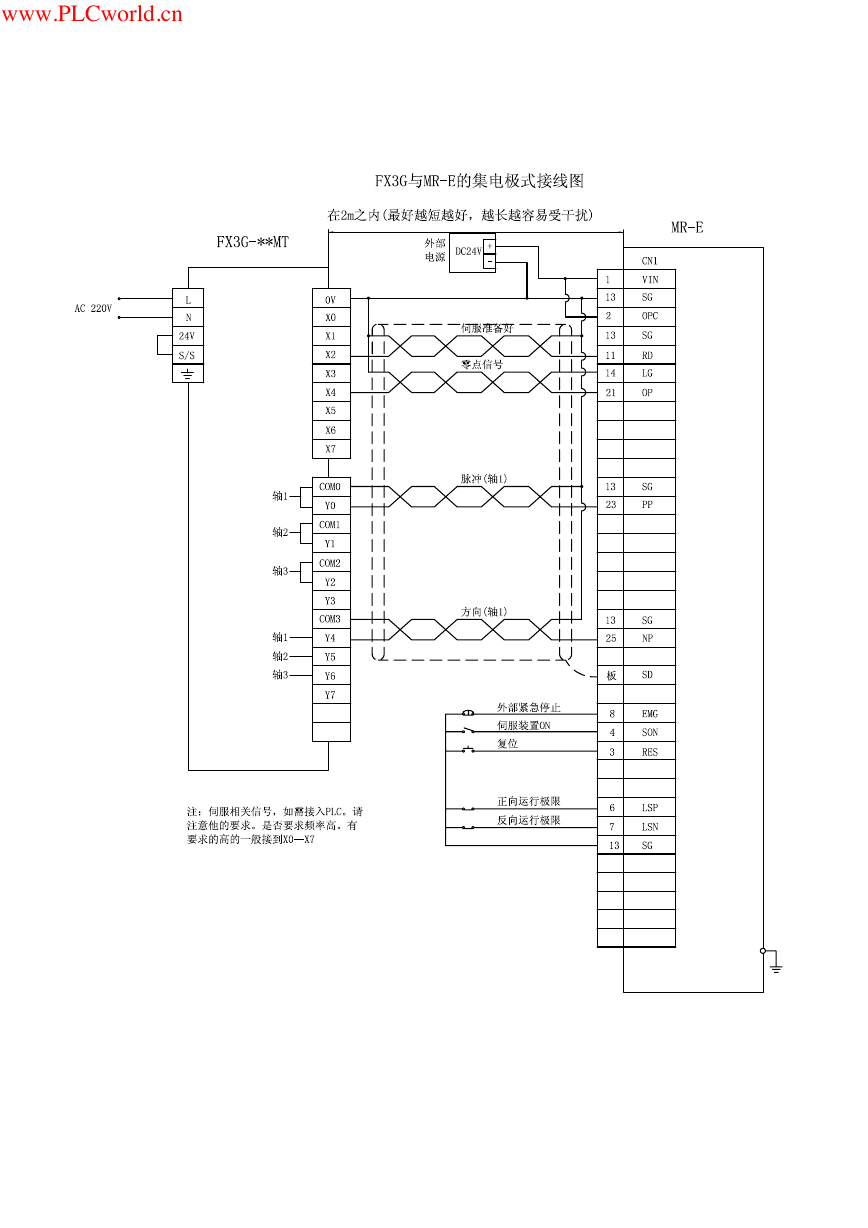 MR-E伺服与FX3G接线图.pdf
MR-E伺服与FX3G接线图.pdf ATK-NEO-6M GPS模块常见问题汇总_201400721.pdf
ATK-NEO-6M GPS模块常见问题汇总_201400721.pdf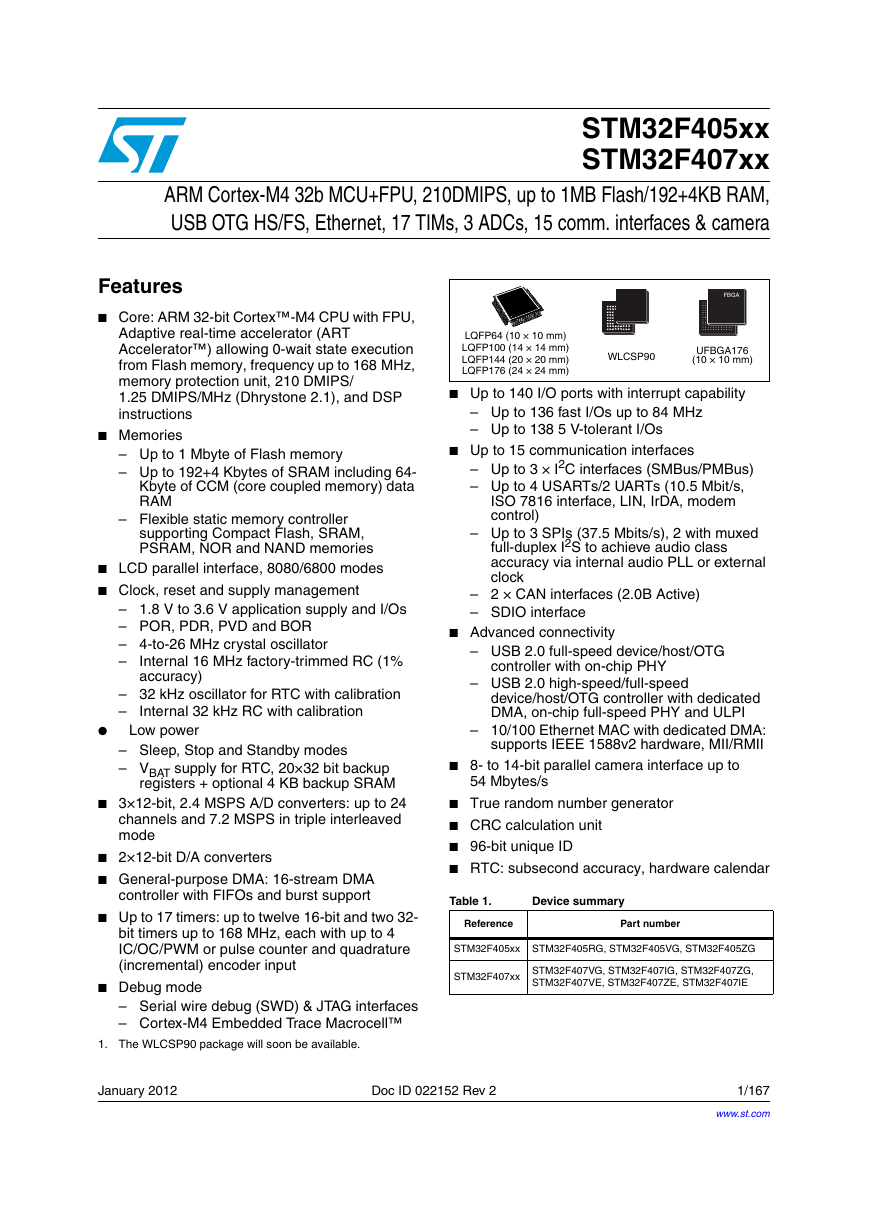 STM32F407ZGT6(芯片资料).pdf
STM32F407ZGT6(芯片资料).pdf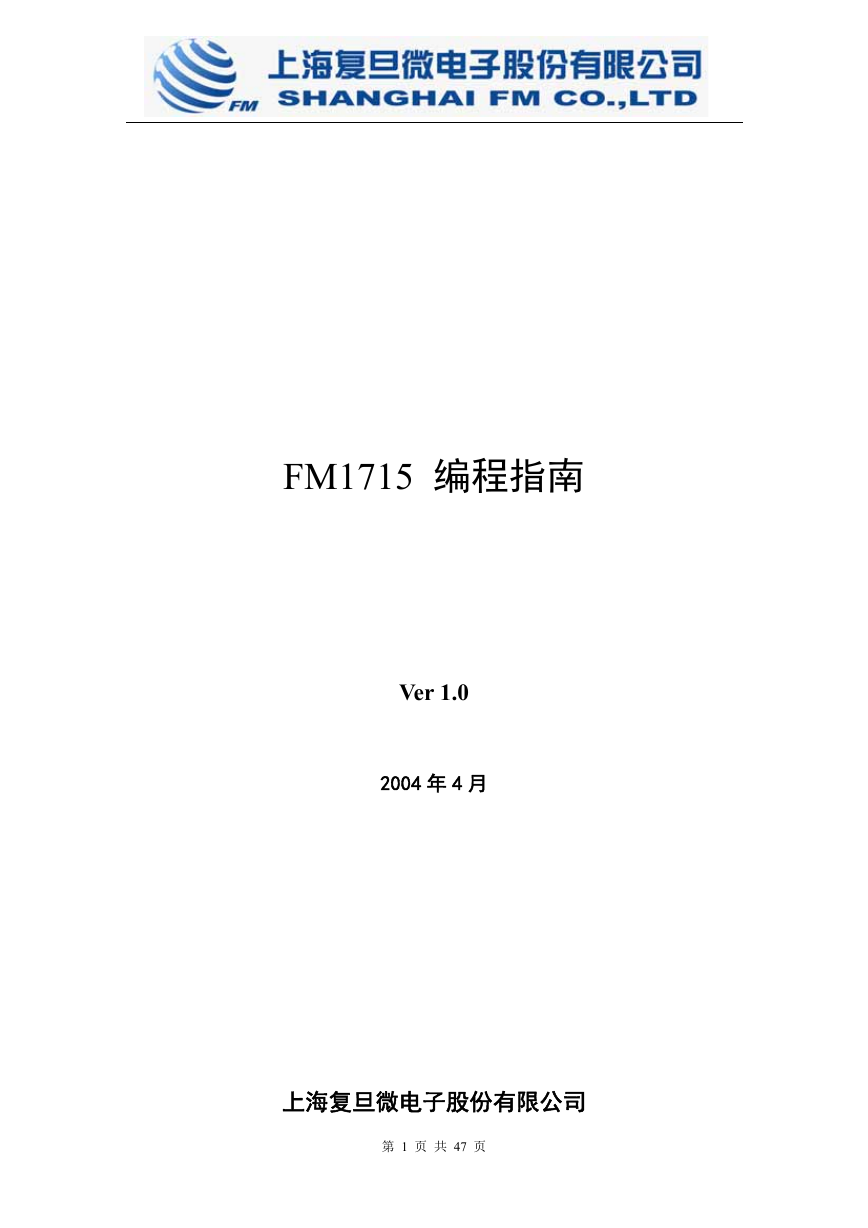 FM1715编程指南.pdf
FM1715编程指南.pdf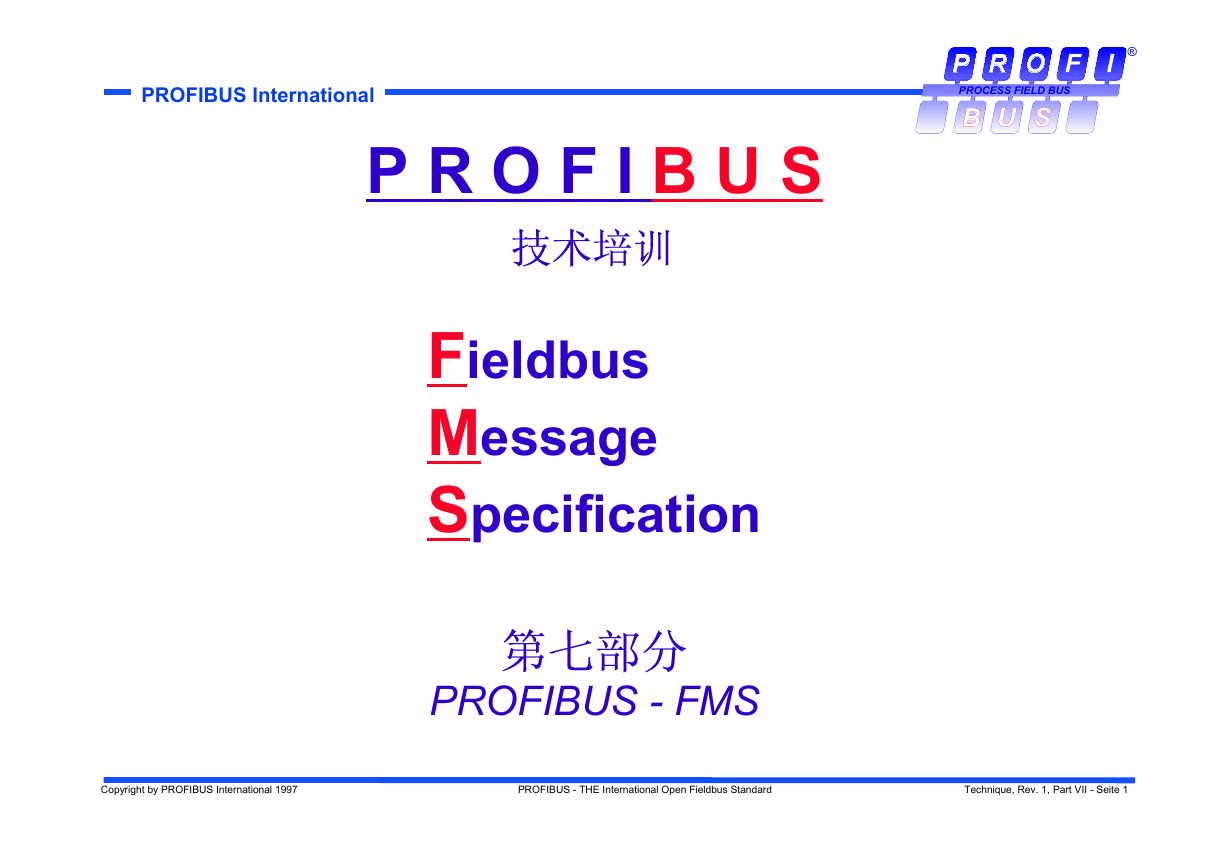 Profibus教程-7.PROFIBUS-FMS.pdf
Profibus教程-7.PROFIBUS-FMS.pdf